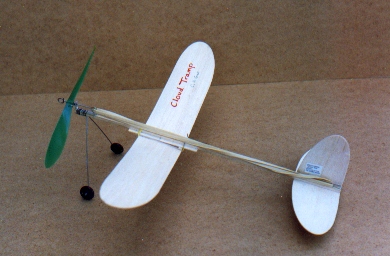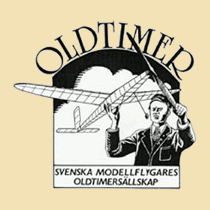
Det finns en världsomspännande modellflygtävling med en enhetsmodell döpt till CLOUD TRAMP. Se hemsida http://www.mikedparker.karoo.net. Där finner du länkar till ritning, deltagarförteckning, resultat från den världsomspännande posttävlingen (se nedan), m.m.
Denna modell flygs vid samma tidpunkt över hela världen och därmed celebrerar vi Charles Grant som grundläggare av vår fantastiska hobby. Starttiden för 2012 kommer att anges på Cloud Tramps hemsida. Här finns bilder på deltagare 2010 från hela världen. Se http://www.mikedparker.karoo.net/mimpic10.html. (Även nyköpingsgänget är med.)
Det finns också en postal tävlingsform utan priser. Gör fem flygningar den sammanlagda tiden för de tre bästa flygningar gäller som resultat . Skicka de fem flygtiderna till jjmoseley@look.ca. Ange namn, ev. klubb och deltagarland. Tävlingen hålls vanligtvis under augusti månad. Kolla aktuellt datum på hemsidan.
Ritning via The Cloud Tramp Homepage
Skala till rätt storlek efter måttangivelserna på ritningen
~ Why are you a model fan? Is it because you enjoy the frustration born of balky gas engines with only
an occasional flight; because you enjoy the labor of building intricate structures; because you thrill to the tug
of a motorized "yo-yo", roaring through repeated circles at the end of restraining control lines;
or is it because you reap deep satisfaction from repeated, realistic, completely stable free flights
requiring minimum construction effort and damage repair? If you prefer the latter, build this simple model.
It will give you as many as 20 to 30 thrilling flights in an afternoon, without breakage, and all within
the bounds of a baseball park.
Longer flights of a minute or more to altitudes of more than 300 ft. can be obtained by
lubricating the motor with glycerin, stretching it 2 1/2 times its length and winding it to
900 turns. The motor should not be wound more than 400 turns when it is dry and wound
by hand. Study the plans carefully and before you start building be sure you know the
exact function, material, size and shape of each part and how all parts are placed and
held together in the assembly.
Start with balsa sheet: medium hard 3 in. (76mm) wide, 1/16 in (1,5 mm) thick.
cut the wing, 22 in. long (558 mm), stabilizers, 10 in. long (254 mm), fin 3-3/4 in. (95 mm) high
Shape the wing tips, the stabilizer and fin outlines all according to the patterns given
full scale in the plans.
From balsa sheet, medium hard, 4 in. (101 mm) long, 3 in. (76 mm) wide, 1/8 in. (3 mm) thick,
cut wing incidence (anfallsvinkel) block and four ribs to the exact outline given in the plans.
Sprygelplacering på vinghalvorna: från mitten till första sprygel 70 mm och från mitten till andra sprygel 178 mm
Then use: balsa: medium hard, 4 in. (101 mm) long, 3/4 in. (19mm) wide,
3/16 in. (5mm) thick.
Cut wing center block from this to length and cross-section shown
in plans. Sand the "V" bottom to precise shape.
Balsa sheet: hard, 2 (25mm) x 2 (25mm) x 1/16 in (1,5mm), from which cut two wing mount strips, 1-5/8 in. 5 and 3/4 in. wide, with grain running crosswise (40x19mm med tvärgående fiberriktning)
Balsa stick (kroppen): hard balsa, 18 in. (457mm) long, 1/4 in. (6x6mm) square cross-section.
Sawed balsa propeller: 8 in. (203mm) long.
Shave down blade faces, round tips,
sandpaper all surfaces and .'balance" on pin through shaft hole. Cut trailing edge at hub
to concave shape shown in side assembly view.
Molded plastic propeller: 8 in. long.
(This may be used if balsa propeller is not available
but flights will be shorter because of greater weight and lower pitch of types now on market).
Wheels: hard wood, 1-1/4 in. (32mm) dia., 1/4 in.(6mm) thick.
Hanger-bearing for prop: steel, "L" shape, legs 13/16 (20mm) and 5/16 in.(8mm) long, cross-section half round 3/22 in. (4mm) wide.
Washers: two, brass, 3/16 in.(5mm) outside diameter., 3/64 in.(1,2mm) hole (min.) , on propeller shaft between propeller and bearing.
Steel wire: hard (not annealed), 21 in. (550mm) long, .032-.035 in.(1mm) diameter.
From this make Landing gear, prop shaft, tail hook, and motor hook according to size
and shape given in plans. (Prop. shaft, tail and motor hooks are shown full scale).
Rubber for motor: 10 ft. long (3m), bredd 1/8(3mm) x tjocklek 0,8 mm.
Quick drying, waterproof model cement.
Miscellaneous implements, as pins, clothespin spring-clamps, sandpaper, pliers, knife, razor blade, etc.
To assemble, crease wing sheet at exact center and cement "V" center block in the crease.
Hold in place until dry with pins and clamps as indicated, and support wing tips at dihedral
angle shown until dry.
Cement four wing ribs to under surface of wing: hold with pins and clamps until dry.
Cement incidence (anfallsvinkel) block to wing "V" block rear edge.
Cement stabilizer and fin to motor stick : hold until dry with pins.
Cement prop hanger-bearing to top of motor stick and bind firmly with thread.
Bind landing gear to underside of stick be- low bearing with thread, using plenty of cement to coat joint.
Put wheels on axles and bend up wire ends with pliers.
Cement tail hook to rear of motor sticks.
Pass end of prop shaft through prop, bend over end into loop and drive loop back into front
face of hub after applying cement to loop.
Cement wing mount strips to motor stick at location shown.
Fasten wing in place on mount with 2-1/2 in.(38mm) rubberband ( use two if required).
Place washers on prop shaft and hook shaft into bearing.
Hook motor "S" hook over tail hook and string four slrands of rubber through the prop shaft hook
and the "S" hook, without tension. Tie ends of rubber together and locate knot at rear
end of motor by adjusting the rubber loops.
The motor should include four strands of rubber, (two loops). One extra strand may be used
with Sawed Balsa Prop when ROG take-offs and high climbing rates are desired.
Care in constructing, finishing and alignment your Cloud Tramp will give you
the most reliable and best performing model plane you have ever built.
Don´t let its simplicity fool you.
To fly, balance plane on ends of two fingers, supporting plane at two points,
each about 2 in.(50mm) from and on opposite sides of the center wing chord from one
another and just half way between leading and trailing edges.
If plane does not balance level, move the wing back and forth along the stick as
required to bring plane in balance when supported on fingers.
When in balance, glide plane gently from hand launch.
When glide is smooth and even, wind motor by the propeller about 100 turns and hand
launch gently. If plane flies without stalling or diving, wind about 300 turns and launch
for a long flight.
If plane stalls, move wing back 1/4 in. (6mm) If it dives, move wing forward 1/4 in.
Then wind it again and fly, adjusting wing on stick until flight is even.
Maximum winds by hand are 400; with winder, 900.


An Alternative Wing Joint and Saddle for the Cloud Tramp
I have attached a picture, received from Pat Seale in Wisconsin, which shows the modifications.
The alteration in point, is that two additional 1/8" ribs are cut and
glued to the inside end
of each half of the
wing. The mating ends of the two half wings are then sanded to a good
fit at the correct dihedral angle and glued
together.
Off cuts from the ribs are glued to the top surface of the wing about 3/8"
from the centreline, then planed or sanded flat to take a 1/16
platform which of course abuts the mounting pieces on the motor stick. The required
incidence can be built in to the saddle, or the 1/8" sheet incidence
block indicated on the plan can be glued to the trailing edge end.
This modification also helps to avoid warps that can very easily creep into a
flat, flexible surface.
Millimetermåttangivelse för landningsstället

Senast ändrad: 2011-11-15


Svenska Modellflygares Oldtimersällskap